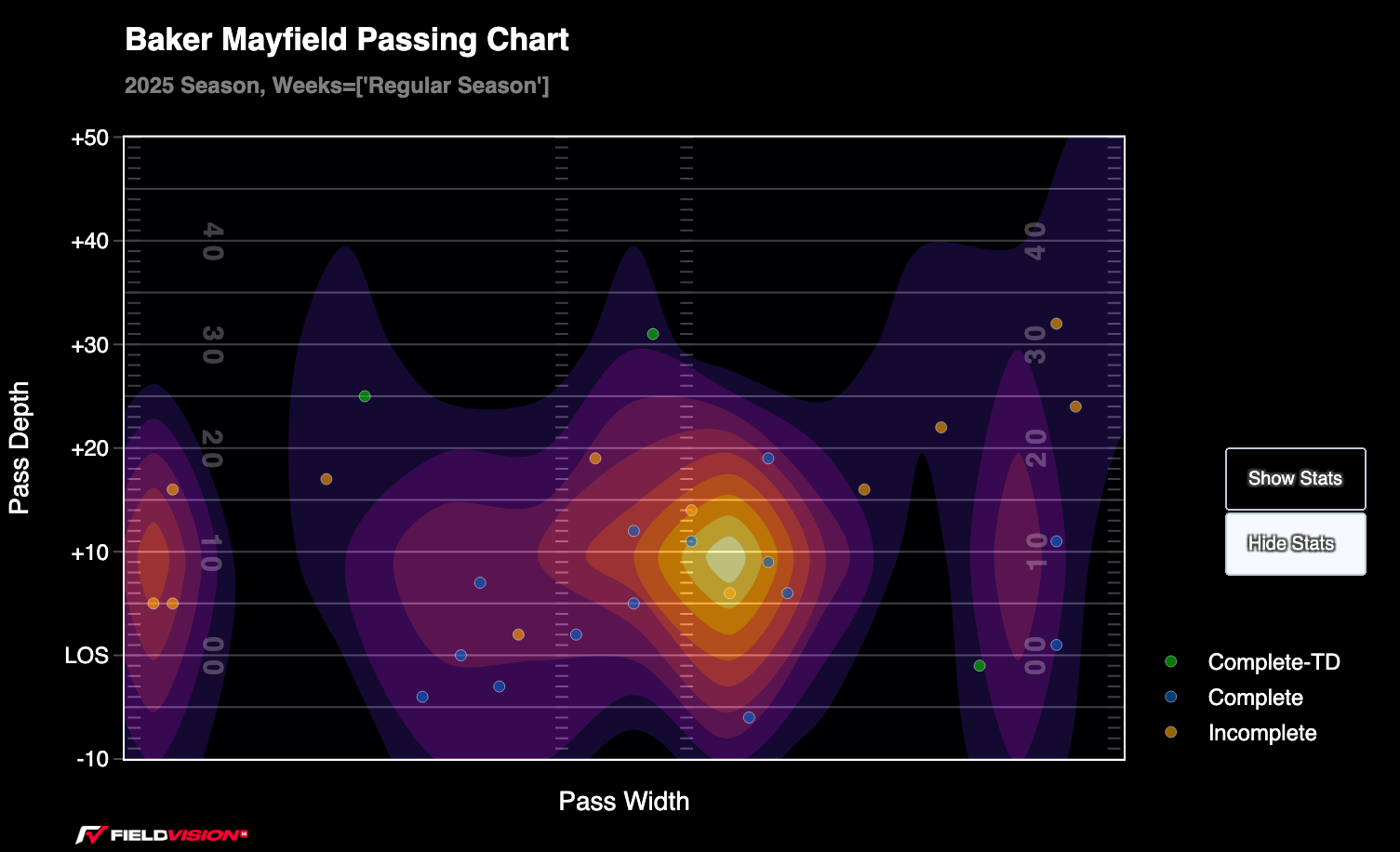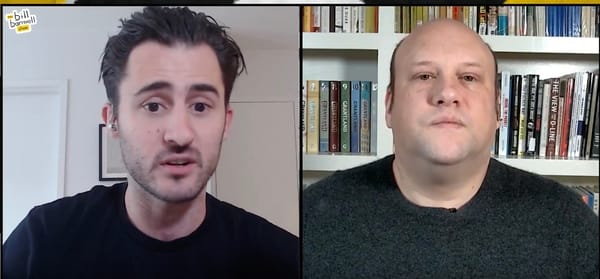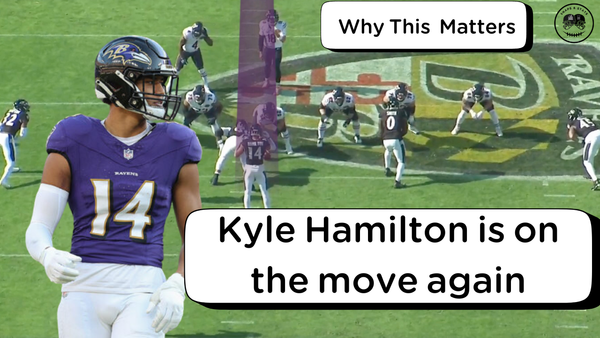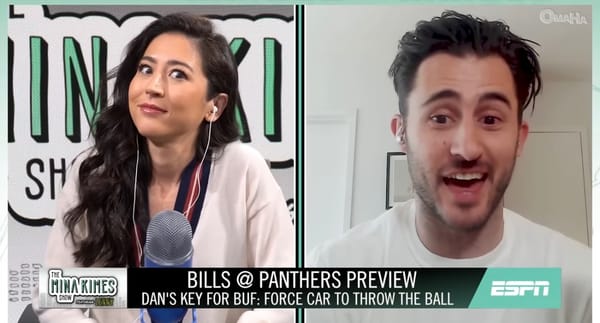The Watchlist: Week 2

Welcome back to The Watchlist. Each week, we’ll go over five things between players, matchups, and trends to keep an eye on for the upcoming week of games. Week 1 gives us some glimpses of what could be for the rest of the season, but sometimes it gives us a false sense of direction. In Week 2 of The Watchlist, we’ll try to tackle a few things to keep an eye on that could matter if they stick throughout the year.
Note for those receiving this via email and reading there: the hope is the delay in posting was worth it for video clips working in the email, as I tried to find a solution. That was an issue with previous versions. Hopefully, it works now. If not, they work on site and I’ll keep working on it.
1. Robert Saleh is back
When the New York Jets fired Robert Saleh last season, the immediate thought was he’d land back in San Francisco as the defensive coordinator for the 49ers. It was a familiar pairing for a team that had tried to replicate Saleh’s defense in his absence, but couldn’t fully make it work. If Saleh’s first game back with the 49ers is any indication, this won’t be the same old defense — there’s an evolution, especially along the defensive front.
The 49ers didn’t blitz often (29.2% ranked 18th in Week 1) but they did have the second-highest rate of bringing seven defenders in the pass rush (7.8%), per MatchQuarters. Combine that with some of the stunts and sim pressures up front and the 49ers were rarely giving away a static look up front.
On the first third down of the game, the 49ers sent six, including both linebackers Fred Warner and Dee Winters, and ran a stunt with Nick Bosa. Yetur Gross-Matos (94), a 265-pound pass rusher who played all 16 of his snaps along the interior per Next Gen Stats, pushed through the center to open up the lane for Bosa to get to Sam Darnold.
On a second-and-11 in the second quarter, the 49ers came out with a four-man front. When Kenneth Walker motioned from the backfield to the slot on the left, the Niners shifted the line and Mykel Williams stood up. Having an edge rusher stand out could be a giveaway about what’s coming — likely a sim pressure with Williams dropping off — but the 49ers still sent five with both linebackers and that allowed Bryce Huff to have a free path to Darnold.
Then on the next play, the 49ers came out with three linemen to the right side of the offense and Warner standing up in the B-gap to the left side. San Francisco ends up bringing six, with Gross-Matos dropping out from over the right tackle and a slot blitz from the left. What impacted the play the most was Warner and Winters going through the same gap, with Winters blowing through Zach Charbonnet’s attempt to pick up the blitz.
San Francisco played single-high behind every blitz, per MatchQuarters and FTN. When that single-high was played as man coverage (42.9%), San Fransico did not allow a single yard. But there were some holes in the zones and the 49ers allowed 12.8 yards per dropback. Overall, the coverage held up. The 49ers ranked a league-best -0.56 EPA per play when in single-high coverages.
With so many injuries hitting the offensive side of the ball, the San Francisco defense will need to do a heavier lift and that could be bad news for Spencer Rattler and the New Orleans Saints in Week 2.
I talked about the 49ers and other new developments from Week 1 with Robert Mays on The Athletic Football Show this week. Incredibly fun show, and thanks to Robert for having me on.
2. Will Justin Herbert Keep Scrambling
For most of his career, Justin Herbert has played like a robot — for better or worse. Herbert was programmed to read the defense and know the progressions right to when the checkdown should come. It’s technically correct, but it often puts a ceiling on what could happen on a given play. Most of the league’s best quarterbacks try shit even if it’s not supposed to work. Herbert can rip some throws into tight coverage but hasn’t used his legs as an option often enough.
There was a stretch over a few games last season when Herbert decided to take off and it resulted in some of the best games on offense but that wasn’t a rate that sustained throughout the rest of the season, partly due to an ankle injury that was reaggravated late in the year.

By the end of the season, Herbert’s scramble rate (5.4%) was still below the previous season (6.0%), though the second-highest of his career. When Herbert got outside of the pocket, he actually had the sixth-highest scramble rate in the league (33.7%), per FTN. Meanwhile, on throws outside the pocket, Herbert averaged just 4.6 yards per attempt, which ranked 36th among quarterbacks.
Herbert, to his credit, has been one of the better runners in the league. Last year on scrambles, he averaged 9.4 yards before contact while he also tied Lamar Jackson for third among quarterbacks with six forced missed tackles on scrambles.
In Week 1, the Chiefs played man coverage 61% of the time, which was the third-highest rate in the league. Typically, man coverage leaves a defense more susceptible to scrambles because the defenders turn their backs to the quarterback while running with the receivers. But last year, Herbert had a higher scramble rate against zone coverage (6.1%) than man (4.7%).
Against the Patriots in Week 1, the Raiders played the fourth-highest rate of zone coverage at 68%. However, the Raiders also played one of the highest rates of base defense at 57.4%. The Chargers were 19th in the use of 11 personnel in Week 1 and opted to use a bunch of heavier packages with 21 and 22 personnel. If the Raiders keep more linebackers on the field, there could be more room for Herbert to run past bigger defenders.
3. Jihaad Campbell might already be a guy
This is a Super Bowl rematch but there is a lot of turnover for both of these teams from what they looked like in that matchup with both additions and subtractions. The biggest addition for the Eagles, one that already turned out to have a major impact in the opener against the Cowboys, was the selection of Jihaad Campbell in the first round to add to the linebacking corps. With Nakobe Dean out to start the season, Campbell jumped in and played 91% of the defensive snaps in Week 1.
Campbell had a few impact plays — he ran the seam and had a pass breakup in the third quarter and then a few plays later forced a fumble while the Cowboys were in the red zone. Those types of plays were just part of how Campbell was a big piece of Philadelphia’s game plan against Dallas.
Let’s go to the fumble. Knocking the ball out is great but we can look at how Campbell was in that position to start. The Eagles came out with a five-man front with three defensive tackles (Jordan Davis, Byron Young, and Moro Ojomo) all on the field. Before the snap, Campbell bumped down to the line and the Eagles had a six-man front with a late shift. The tight end and left tackle still took on the end, which left Campbell only needing to slip by a pulling fullback.
The Eagles did this several times throughout the game, moving Campbell down to the line of scrimmage late to shift the front and mess with the blocking rules for the offensive line. It didn’t always work — the 49-yard Miles Sanders run that put the Cowboys into the red zone before the fumble was opened up by Campbell getting blocked out of the play on the edge — but the changing picture is something the Eagles can continue to use throughout the season.
Then there was Campbell’s coverage. He was not charted with a yard allowed in coverage on 34 coverage snaps, per PFF. A lot of his coverage came sitting in the middle zone and he showed range on the seam deflection, but one of his best coverage reps might have been a few plays later and just before the fumble. Campbell was bumped out to the slot against an empty formation and was matched up against George Pickens. Noticing the matchup, Dak Prescott first looked over but didn’t see an opening before he came back to the middle and left a pass to Jake Ferguson short with Zach Baun in coverage.
It’s another layer for the Chiefs to face along the offensive line and if they continue to use the short area of the field in the passing game.
4. Emeka Egbuka vs Houston’s defense
Emeka Egbuka had one of the most promising rookie debuts in Week 1. In Tampa Bay’s 23-20 win over Atlanta, Egbuka had two touchdowns on four catches and six targets. He ran half of his routes from the slot and half of his routes outside, but only had one catch for nine yards from the slot.
On his first touchdown, the Buccaneers found a way to sneak him out into space downfield. Egbuka started condensed with Ryan Miller to the right side and Tampa Bay motioned a tight end over to make a tight bunch. Egbuka ran a deep over through the holes in the Atlanta zone and Baker Mayfield placed a throw over the dropping defender.
His second touchdown came with the defense stretched out as the Buccaneers were in empty. Egbuka was on the outside of the trips side and fake a move to the outside before he broke in on a post with separation against Mike Hughes.
Baker Mayfield, in his first game with new offensive coordinator Josh Grizzard, had his most success throwing into the intermediate middle of the field, especially to his right — getting some targets to Mike Evans and Sterling Shepard.

But there was little success from anyone in the slot. Evans led the team with 1.2 yards per route run from the slot, per FTN. Mayfield only went 3-of-6 for 3.9 yards per attempt and -0.29 EPA per play when targeting players from the slot.
Houston has a much better defense against outside receivers, with Derek Stingley Jr. and Kamari Lassiter at cornerback. Last week against the Rams, the Texans allowed 7.5 yards per attempt to outside receivers and 12.9 yards per attempt from the slot. Of course, that is also a Puka Nacua stat, but that’s what we’re watching for with this matchup. If Egbuka can be deployed as a consistent weapon from the slot to work away from top outside corners, that would not only open things up in Week 2 and this specific matchup, but it would be a plus once Chris Godwin returns to the lineup.
5. Can The Vikings Build On The Fourth Quarter?
J.J. McCarthy had an uneven NFL debut against the Bears on Monday Night Football. Through three quarters, the Vikings couldn’t do much on offense, but a fourth-quarter turnaround sparked a come-from-behind win.
Early in the game, it appeared that McCarthy and Kevin O’Connell were still in a feeling-it-out mode against a Dennis Allen Bears defense that was making things difficult on the first-year starter. The Vikings wanted to keep things simple for McCarthy, relying on the run game and not forcing the quarterback to carry the offense with his arm. Minnesota had a -16% pass rate above expectation on first-and-10 but that jumped to 74% on second-and-short — that’s trying to get the quarterback in advantageous pass situations.

However, in trying to help McCarthy out, there was a cap put on the explosiveness of the offense. Through three quarters, McCarthy only had a 3.3-yard aDOT and averaged 4.9 yards per attempt with a pick-6. In the fourth quarter, the Vikings opened up the offense while still helping out the quarterback. Minnesota stuck to the play-action game despite trailing for much of the game and they bumped that rate during the comeback. After a third of McCarthy’s dropbacks used play-action in the first three quarters, that rate was 50% in the final quarter. The Vikings also took the opportunity to push the ball downfield. McCarthy’s aDOT jumped to 9.6, and he took his only two shots of 20 or more air yards.
That fourth quarter looked more like the 2024 Minnesota offense with a plus run game. The Vikings ran 13 times for 82 yards in the fourth quarter and averaged 0.42 EPA per rush. Minnesota has spent basically the entire Kevin O’Connell tenure trying to build a productive running game. The rushing success kept them in the game and prevented the Vikings from having to rely on long-developing straight dropbacks while they trailed.
Atlanta ranked seventh in DVOA against the run in Week 1, stopping Tampa Bay from getting much going on the ground. Like the Buccaneers, the Vikings will be without their starting left tackle. Christian Darrisaw was listed as questionable for the season opener and worked out pregame, but was then declared inactive. He’s already been ruled out for the Sunday night game against the Falcons. Even with a big missing piece, the interior additions of Ryan Kelly and Will Fries could make up for it, especially as the team leans on the run and play-action game.





